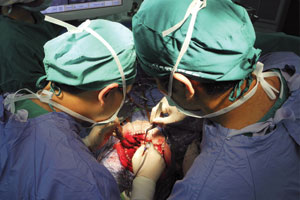EPILEPSY surgery is underutilised and should be considered earlier in the one-third of epilepsy patients who are refractory to medical treatment, Australian experts say.
New research published in Epilepsia found that among 117 epilepsy surgery patients, 48% were seizure-free after a mean follow-up of 26 years. (1)
The study found 80% of patients reported better quality of life than before surgery.
Dr Andrew Bleasel, a neurologist at Westmead Hospital, Sydney, and president of the Epilepsy Society of Australia, said the study confirmed previous research showing good long-term outcomes from epilepsy surgery.
A study published in The Lancet late last year found that 63% of patients were seizure-free 2 years after epilepsy surgery, while 47% were seizure-free 10 years after surgery. (2)
Dr Bleasel said the Epilepsia research was valuable because of its very long-term follow-up. However, he raised concerns that only 32% of the patients who had surgery (between 1967 and 1990) could be located and interviewed an average of 26 years later.
The study would have been stronger if the researchers had prospectively followed the cohort throughout the intervening years, as The Lancet researchers and other centres had done.
Dr Bleasel said the main barrier to uptake of epilepsy surgery was that patients with uncontrolled seizures were not referred early enough for assessment for surgery, or not referred at all.
“We see people who have had the problem for 26 years and who could have been dealt with in the first 3 years”, he said.
Dr Bleasel said there was a misconception among clinicians that surgery was a last resort but patients with uncontrolled seizures despite multiple medication attempts should be referred for assessment for surgery.
“That’s the most dangerous misconception because people miss years of their lives … as they struggle on with failed medical treatment”, he said.
Some patients or clinicians were reluctant to pursue surgery because it was not 100% effective. However, it compared favourably with attempting to control the epilepsy with medication, Dr Bleasel said.
“If you’re failing with medical therapy the chance that continuing rounds of drugs will be effective is only about 10%.”
He hoped surgery uptake would improve through clinician education.
Associate Professor Gavin Fabinyi, a neurosurgeon at Austin Hospital, Melbourne, agreed that the low referral rate was probably an educational issue.
“Epilepsy surgery is safe and mainstream … it’s no longer experimental”, he said.
“Are we operating on enough people? The answer very clearly is no, and we’re operating on people too late.”
He said there was also a need for more multidisciplinary centres providing epilepsy surgery in Australia. His centre at Austin Hospital operated on many Queensland patients because of a lack of services in that state.
Professor Fabinyi said experience at his centre had shown that there was a late relapse rate after epilepsy surgery, which occurred about 10 years after the procedure but could usually be controlled with medication.
“There is a late relapse, it’s not a matter of saying after 2 years, ‘you’re cured’ … it’s quite clear that we need to follow up patients long term and that they should be treated with tablets for probably longer than 2 years”.
Professor Fabinyi said epilepsy surgery today would have even better outcomes than those in the Epilepsia paper, largely because of improvements in imaging.
“The better the [magnetic resonance imaging], the better able we are to pick where to operate. The main reason for improvement is not the surgical techniques; it’s the [quality of] imaging”.
– Sophie McNamara
1. Epilepsia 2012; February 7 (online)
2. Lancet 2011; 378: 1388-1395
Posted 13 February 2012

 more_vert
more_vert